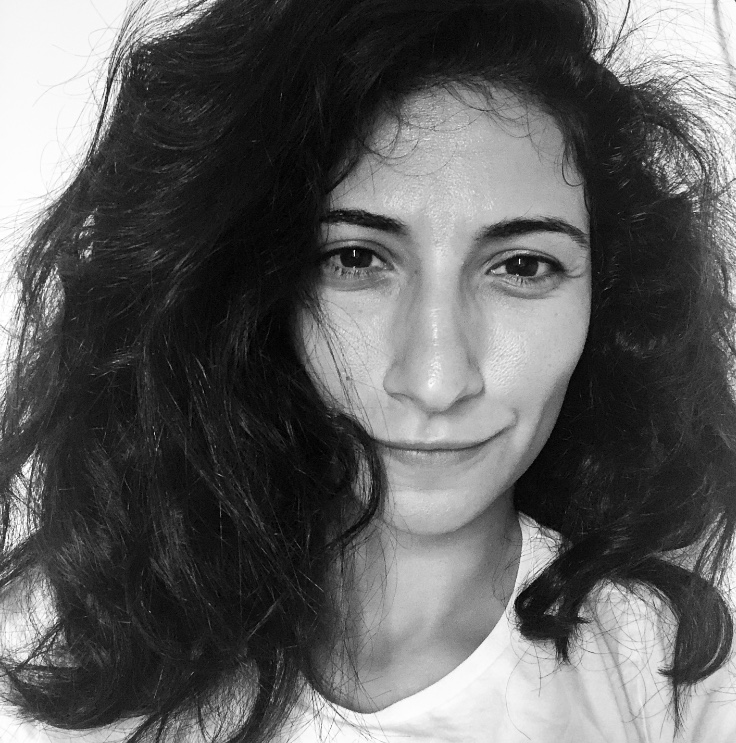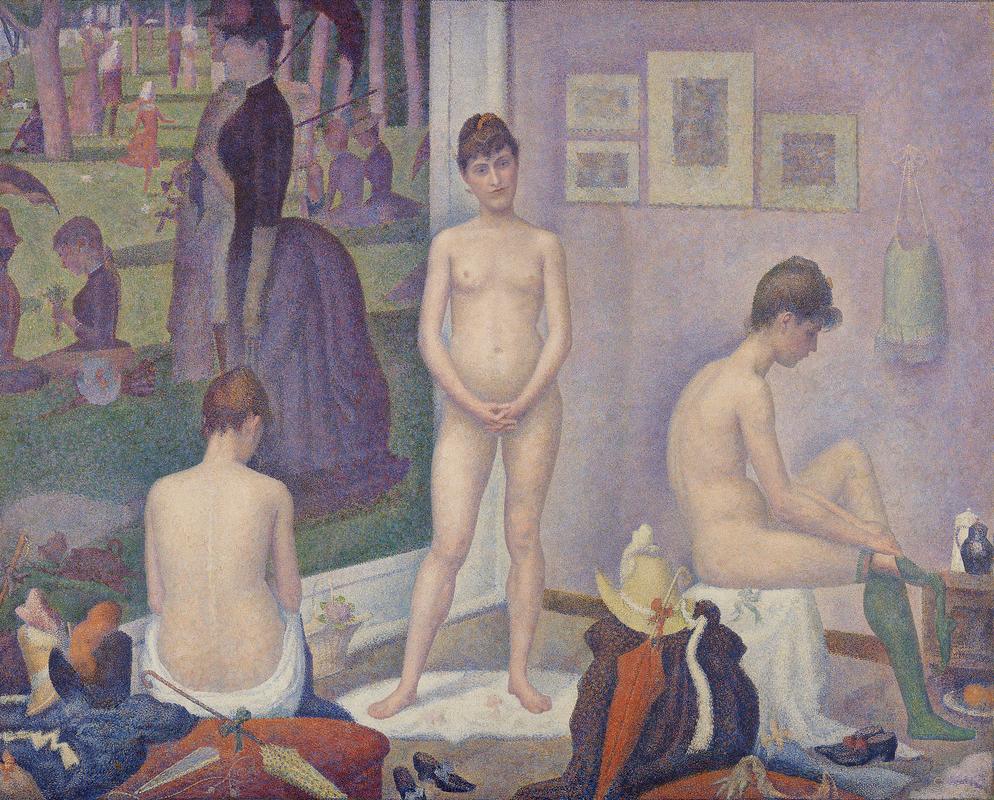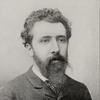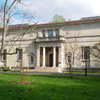More about Models

Contributor
In Models, Georges Seurat gets meta by painting a woman posing for another one of his paintings: A Sunday Afternoon on the Island of La Grande Jatte.
At first glance, it is as though the three pale models stepped out of the park scene depicted in Sunday Afternoon and started stripping their clothing off. Seurat’s studio is littered with clothes and parasols, props for his models to dress up in. Or is it model, singular? The three models may be the same woman, in three different poses. Notice the red comb in the hair of the central figure - it shows up in the hair of the sitting on the right, and all three sport the same up-do hairstyle. Seurat leads you to believe he’s used the same woman to model three times for him in the space of his studio by capturing her in three movements: standing ready for Seurat, removing her clothing, then getting dressed again. In this way he pulls back the curtain on the creative process, instead of presenting a static, finished scene, like in Sunday Afternoon.
The model most likely did not live the life of the elegant figures roaming serenely through the park behind her; rather, it’s possible she was a sex worker and, in any case, artist model and prostitute were both considered "low-class" occupations in 19th century Paris. Seurat paints the central girl standing tall, with a tilt to her head and a smirk dancing on the lips. Being nude in front of the artist does not appear to embarrass the confident woman, as if she is used to the job.
Seurat's choice to show the working class women at, well, work, may have been a strategic response to criticisms that Sunday Afternoon was cold and that the Pointillist technique rendered human figures too unrealistically - knocks that were upsetting to a man intent on being a painter of modern Parisian life! The painting's title in French Poseurs more directly translates to "Posers," and the juxtaposition of the model preparing for her job in his studio next to the painting hanging on the wall emphasizes that she is a real woman, shown here unidealized, ironically not posing, but putting on her socks one foot at a time, just like everybody else.
Famed art historian Linda Nochlin has even gone so far as to argue that this painting is feminist in its subversion of the traditional female nude, writing that by presenting the women "as nothing more or less than what they are - contemporary urban working women - Seurat rejected the traditional notion of the female nude as both timeless and quintessentially natural." So, while comparisons to The Three Graces are certainly apropos, Seurat's reference is tongue in cheek, as these women are not muses, or goddesses, but are simply modern girls trying to get through their 9 to 5.
Pointillism requires millions (okay, maybe just hundreds of thousands) of hand-painted dots to create figures and scenes with optical tricks. Seurat applied the same method of painting to Models, with a change of scene (while A Sunday Afternoon on the Island of La Grande Jatte was sketched outside, en plein air, this is study of the indoors). Seurat scrutinized light and shadow, sketched rigorously, and painted many studies before tackling this large canvas. His efforts were worthwhile as the painting was well received; a fashionable French magazine published the illustration of the central model when Models was being exhibited at the Salon des Independants.
Seurat’s Models still makes waves on the contemporary art scene. In 1993, Carla Bruni, a model, singer, and former First Lady of France, posed nude in an homage to Seurat’s center model for a monochrome photograph. In 2008, a Chinese collector paid well over the estimated price for the photo, buying it for $91,000 USD.
Sources
- Christie’s, “10 of the best Impressionist paintings sold at Christie’s,” May 13, 2020. Accessed November 17, 2020. https://www.christies.com/features/10-greatest-Impressionist-paintings-…
- David D’Arcy, “All the world loves a clown: circus sideshow at the Met,” Observer, February 2, 2017. Accessed November 17, 2020. https://observer.com/2017/02/clown-art-at-met-museum-circus/
- Foa, Michelle. Georges Seurat: The Art of Vision. New Haven, CT: Yale University Press, 2015.
- Nasaw, Daniel, “Bruni nude photo sells for $91,000,” The Guardian, April 11, 2008. Accessed November 17, 2020. https://www.theguardian.com/world/2008/apr/10/usa.nicolassarkozy?gusrc=…
- National Gallery of Australia, “Georges Seurat: Model from the front,” accessed November 18, 2020. https://nga.gov.au/exhibition/masterpiecesfromparis/default.cfm?IRN=191…
- Nochlin, Linda. "Body Politics: Seurat's Poseuses." Art in America. New York: pp. 71–124. (March 1994).
- Raine, Craig. “Chapter Seurat’s Courage (1997),” More Dynamite. London, GB: Atlantic Books, 2013.
- Richman-Abdou, Kelly, “The story behind Seurat’s Pointillist masterpiece, ‘A Sunday Afternoon on the Island of La Grande Jatte,’” My Modern Met, July 21, 2019. Accessed November 17, 2020. https://mymodernmet.com/georges-seurat-a-sunday-afternoon-on-the-is
- Stewart, Jessica, “Art lovers and volunteers recreate Georges Seurat’s famous painting in real life,” My Modern Met, February 14, 2020. Accessed November 17, 2020. https://mymodernmet.com/seurat-recreation-beloit/
- Thomson, Richard. “Seurat’s Circus Sideshow: A Parade of Paradoxes,” Seurat’s Circus Sideshow, edited by Richard Thomson. New York, NY: The Metropolitan Museum of Art, 2017.
- Thomson, Richard. “The Imperatives of style: Seurat’s drawings, 1886-1891,” Georges Seurat: The Drawings. New York, NY: The Museum of Modern Art, 2008. Edited by Jodi Hauptman.
- Tobutt, Rosie, “Painting Prostitution: 8 infamous portraits of art’s illicit muses,” Culture Trip, October 30, 2016. Accessed November 18, 2020. https://theculturetrip.com/europe/france/articles/painting-prostitution…
Featured Content
Here is what Wikipedia says about Models (painting)
Models, also known as The Three Models and Les Poseuses, is a work by Georges Seurat, painted between 1886 and 1888 and held by the Barnes Foundation in Philadelphia. Models was exhibited at the fourth Salon des Indépendants in spring of 1888.
The piece, the third of Seurat's six major works, is a response to critics who deemed Seurat's technique inferior for being cold and unable to represent life. As a response, the artist offered a nude depiction of the same model in three different poses. In the left background is part of Seurat's 1884–1886 painting A Sunday Afternoon on the Island of La Grande Jatte.
Models is considered distinctive because of its pointillist technique and the political implications of its depiction of the nude female body.
Check out the full Wikipedia article about Models (painting)












